Posterior Esthetic Dentistry -
A Perspective for the New Century
• Ken A. Neuman, DMD •
© J Can Dent Assoc 1999; 65:556-7
Posterior esthetic dentistry. What did it mean 50 years
ago? What does it mean today? Twenty years ago, dentists had few choices for restoring
posterior teeth. Assuming a patient did not need full-coverage crowns, posterior teeth
were only restored with amalgam or cast gold. Despite its great shortfall in esthetics,
amalgam remained the material of choice for most dentists because it was relatively easy
to use and inexpensive. In the words of the late Dr. Ronald Jordan, “Amalgam was
among the most forgiving of all dental materials.”
However, clinicians who could make amalgam look esthetic were few in number. Even
though talented master dentists like Dr. Miles Markley and Dr. Harold Shavell could create
perfect tooth morphology and function using amalgam, the restorations could never be
called esthetic because of their colour.
For patients who could afford it, cast gold was the material of choice. Even today, the
intricate and expensive laboratory procedures associated with gold restorations ensure an
incredibly strong material with an exact replica of natural morphology. However, there is
no choice of colour. Although cast gold is still the strongest material with the greatest
longevity, it is perfectly understandable for most patients to want a natural-looking
mouth when having restorations.
Recently, there has been a dramatic change in the profile of the posterior restoration.
Part of this shift is due to the tremendous improvement in tooth-coloured materials, such
as porcelain and composites, as well as more conservative preparation protocols and
forever changing theories of preparation design. The shift is also due, in part, to a
higher level of education among patients. Given the choice, and shown side-by-side
pictures of teeth restored with amalgam and teeth restored with natural-looking materials,
very few people will select amalgam. With amalgam no longer used in many countries, I
predict that within the next 10 years it will disappear entirely in North America. This
development will again give patients two main choices in restoring posterior teeth —
gold and tooth-coloured.
With tooth-coloured restorations we can preserve more tooth structure, and because the
bond strength of today’s materials has increased so dramatically, we can be
comfortable that we have a replacement for amalgam. The advantages are obvious (Figs. 1
and 2).
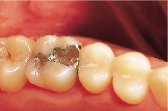 |
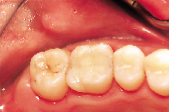 |
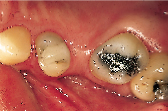 |
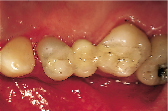 |
| Figure 1: Old amalgam restoration. |
Figure 2: Old amalgam restored with
tooth-coloured bonded restoration. |
Figure 3: Space with missing tooth to be restored
with minimal preparation using inlay preparations. |
Figure 4: Three unit non-metal inlay
bridge bonded into place. |
Preparation designs for indirect tooth-coloured materials have changed considerably
from cast gold, the most important being the use of rounded angles instead of the classic
sharp angles of G.V. Black. We can create very conservative preparations when restoring
posterior areas with a fixed bridge made from metal-free materials, such as the posterior
inlay bridge (Figs. 3 and 4).
In the anterior area, where years ago a three-unit bridge would mean cutting down two
healthy teeth, restorations can be accomplished with minimal preparations (Figs. 5
and 6).
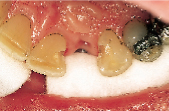 |
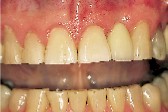 |
| Figure 5: Minimal inlay preparations for anterior
bridge retainers. |
Figure 6: Anterior bridge bonded into
place. |
For young dentists to ignore this dramatic shift in treatment would be a mistake.
Unfortunately, in my opinion very few dental schools in North America are graduating
students with the skills or knowledge to perform posterior restorations with
tooth-coloured materials with any degree of confidence. Even dentists who have been
practising for many years and are trying to shift to tooth-coloured materials will face
frustration and failure because they expect the same time commitment and cost as amalgam.
To be successful, performing tooth-coloured restorations requires precise, new and
unforgiving techniques.
I urge all dentists, whether experienced or recently graduated, to make learning how to
do natural-looking restorations a priority. Prepare yourselves by seeking out the best
continuing education programs and by reading the very latest research in reputable
journals. I have no doubt we are headed in the direction I propose. Be ahead of your time
— enjoy your dentistry to the fullest by doing procedures that are satisfying to both
you and your patients.
The next millennium is quickly approaching. Posterior esthetic dentistry is being
redefined and has an entirely new perspective. Do whatever you need to do to be part of
it. Maybe Oliver Wendell Holmes was talking directly to dentists when he said, “It is
not so important where we stand, as to what direction we are moving in.”
 [ Top ]
[ Top ]
Dr. Neuman is in private practice in Vancouver, B.C.
Reprint requests to: Dr. Ken A. Neuman, 101-2732 West Broadway, Vancouver, BC
V6K 2G4
The views expressed are those of the author and do not necessarily reflect the opinion
or official policies of the Canadian Dental Association.
 [ Top ]
[ Top ]





